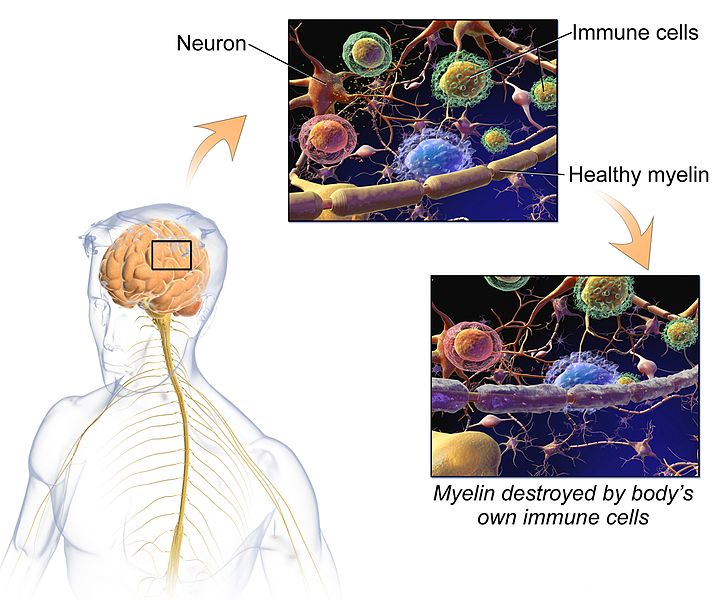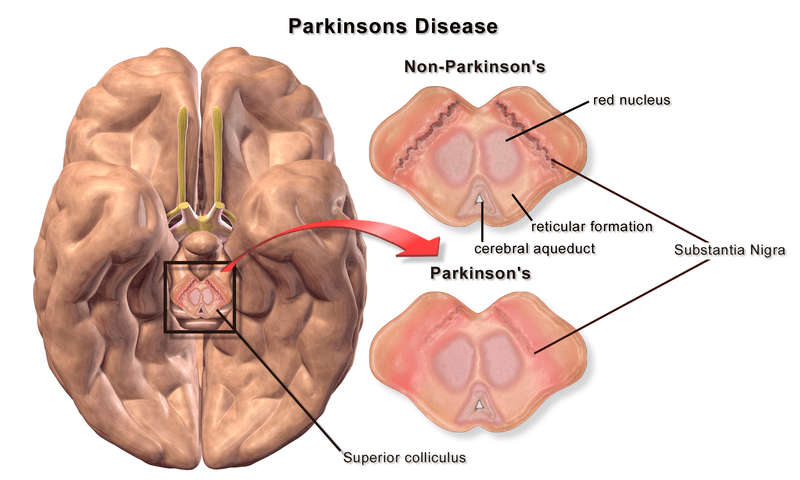Difference Between MS and Parkinson’s
Table of Contents
Key Difference – MS vs Parkinson’s
MS and Parkinson’s disease are two diseases affecting the central nervous system. Multiple Sclerosis (MS) is a chronic autoimmune, T-cell mediated inflammatory disease affecting the central nervous system. On the other hand, Parkinson’s disease is a movement disorder characterized by a decline in the dopamine level of the brain. Although MS is an autoimmune disorder, there is no immune component in the pathogenesis of Parkinson’s disease. This is the key difference between MS and Parkinson’s.
CONTENTS
1. Overview and Key Difference
2. What is MS
3. What is Parkinson’s
4. Similarities Between MS and Parkinson’s
5. Side by Side Comparison – MS vs Parkinson’s in Tabular Form
6. Summary
What is MS?
Multiple Sclerosis is a chronic autoimmune, T-cell mediated inflammatory disease affecting the central nervous system. Multiple areas of demyelination are found in the brain and the spinal cord. The incidence of MS is higher among women. MS mostly occurs between 20 and 40 years of age. The prevalence of the disease varies according to the geographical region and ethnic background. Three commonest presentations of MS are;
- optic neuropathy
- brain stem demyelination, and
- spinal cord lesions
Patients with MS are susceptible to other autoimmune disorders. Both genetic and environmental factors influence the pathogenesis of the disease.
Pathogenesis
T cell-mediated inflammatory process occurs mainly in the white matter of the brain and spinal cord, producing plaques of demyelination. 2-10mm sized plaques are usually found in the optic nerves, periventricular region, corpus callosum, brain stem and its cerebellar connections and cervical cord.
In MS, peripheral myelinated nerves are not directly affected. In the severe form of the disease, permanent axonal destruction occurs, resulting in progressive disability.
Types of Multiple Sclerosis
- Relapsing-remitting MS
- Secondary progressive MS
- Primary progressive MS
- Relapsing-progressive MS
Common Signs and Symptoms
- Pain on eye movements
- Mild fogging of central vision/color desaturation/dense central scotoma
- Reduced vibration sensation and proprioception in feet
- Clumsy hand or limb
- Unsteadiness in walking
- Urinary urgency and frequency
- Neuropathic pain
- Fatigue
- Spasticity
- Depression
- Sexual dysfunction
- Temperature sensitivity
In late MS, severe debilitating symptoms, with optic atrophy, nystagmus, spastic tetraparesis, ataxia, brainstem signs, pseudobulbar palsy, urinary incontinence and cognitive impairment can be seen.

Figure 01: MS
Diagnosis
Diagnosis of MS can be made if the patient has had 2 or more attacks affecting different parts of the CNS. MRI is the standard investigation used in the confirmation of clinical diagnosis. CT and CSF examination can be done to provide further supportive evidence for the diagnosis if necessary.
Management
There is no definitive cure for MS. But several immunomodulatory drugs have been introduced to modify the course of the inflammatory relapsing-remitting phase of MS. These are known as Disease Modifying Drugs (DMDs). Beta-interferon and glatiramer acetate are examples of such drugs. Apart from drug therapy, general measures such as physiotherapy, supporting the patient with the help of a multidisciplinary team and occupational therapy can vastly improve the living standards of the patient.
Prognosis
The prognosis of multiple sclerosis varies in an unpredictable manner. A high MR lesion load at the initial presentation, high relapse rate, male gender and late presentation are usually associated with a poor prognosis. Some patients continue to live a normal life with no apparent disabilities while some can get severely disabled.
What is Parkinson’s?
Parkinson’s disease is a movement disorder characterized by a decline in the dopamine level of the brain. The cause of this condition still remains controversial. The risk of Parkinson’s disease significantly increases with advanced age. A familial inheritance of the disease has not yet been identified.
Pathology
The appearance of Lewy bodies and loss of dopaminergic neurons in pars compacta of the substantia nigra region of midbrain are the hallmark morphological changes seen in the Parkinson’s disease.
Clinical Features
- Slow movements ( bradykinesia/akinesia)
- Resting tremor
- Lead pipe rigidity of the limbs which is identified during clinical examination
- Stooped posture and shuffling gait
- Speech becomes quiet, indistinct and flat
- In the late stage of the disease patient can develop cognitive impairments also

Figure 02: Parkinson’s Disease
Diagnosis
There is no laboratory test for the exact identification of Parkinson’s disease. Therefore, diagnosis is solely based on the signs and symptoms recognized during the clinical examination. MRI images appear to be normal most of the time.
Treatment
The patient and the family should be educated about the condition. Motor symptoms can be alleviated by the use of drugs such as dopamine receptor agonists and levodopa which restore the dopamine activity of the brain. Sleep disturbances and psychotic episodes should be managed appropriately.
Dopamine antagonists such as neuroleptics can induce Parkinson’s disease-like symptoms in which case they are collectively known as Parkinsonism.
What is the Similarity Between MS and Parkinson’s?
- Both diseases affect the central nervous system
What is the Difference Between MS and Parkinson’s?
MS vs Parkinson’s | |
| Multiple Sclerosis is a chronic autoimmune, T-cell mediated inflammatory disease affecting the central nervous system. | Parkinson’s disease is a movement disorder characterized by a decline in the dopamine level of the brain. |
| Causes | |
| Demyelination of nerves in the brain and spinal cord is the pathological basis of the disease. | Parkinson’s disease is due to the decline in the dopamine level of the brain. |
| Clinical Features | |
Common signs and symptoms of MS are,
In late MS, severe debilitating symptoms of optic atrophy, nystagmus, spastic tetraparesis, ataxia, brainstem signs, pseudobulbar palsy, urinary incontinence and cognitive impairment can be seen. | Clinical features of Parkinson’s disease are,
In the late stage of the disease, patient can also develop cognitive impairments |
| Diagnosis | |
| MRI is the standard investigation used in the diagnosis of MS. In addition to that CT can also be used depending on the facilities available. | There is no laboratory test for the exact identification of Parkinson’s disease. Therefore diagnosis is solely based on the signs and symptoms recognized during the clinical examination. MRI images appear to be normal most of the time. |
| Medicine | |
| Disease-modifying drugs such as beta-interferon and glatiramer are used in the management of MS. | Motor symptoms are treated with levodopa and dopamine agonists. |
| Genetic Predisposition | |
| There is a genetic predisposition. | There is no evidence to suggest a genetic predisposition. |
Summary – MS vs Parkinson’s
Multiple Sclerosis is a chronic autoimmune, T-cell mediated inflammatory disease affecting the Central Nervous System. Parkinson’s disease is a movement disorder characterized by a decline in the dopamine level of the brain. Multiple sclerosis, as stated in its definition, is an autoimmune disease but Parkinson’s disease is not an autoimmune disease. This is the major difference between MS and Parkinson’s.
Download PDF Version of MS vs Parkinson’s
You can download PDF version of this article and use it for offline purposes as per citation notes. Please download PDF version here Difference Between MS and Parkinson
References:
1. Kumar, Parveen J., and Michael L. Clark. Kumar & Clark clinical medicine. Edinburgh: W.B. Saunders, 2009.
Image Courtesy:
1. “Multiple Sclerosis” By BruceBlaus (CC BY-SA 4.0) via Commons Wikimedia
2. “Blausen 0704 ParkinsonsDisease” By “Medical gallery of Blausen Medical 2014”. WikiJournal of Medicine 1 (2). DOI:10.15347/wjm/2014.010. ISSN 2002-4436. – Own work (CC BY 3.0) via Commons Wikimedia
ncG1vNJzZmivp6x7pbXFn5yrnZ6YsqOx07CcnqZemLyue8OinZ%2Bdopq7pLGMm5ytr5Wau2650maYp5xdq8BuvMCroqKmo6S7tHs%3D